As summer descends upon the Chicagoland area, the heat can take its toll on your lawn, turning lush green grass into a dry, brown eyesore. However, with the right care and attention, you can maintain a healthy and vibrant lawn even during the hottest and driest periods. In this blog post, we’ll explore seven essential tips to help you keep your lawn green and thriving throughout the summer months.
(We receive no compensation for any of the products mentioned in this article with the exception being our own lawn soil blends.)
Water Wisely![Water Wise;ly]()
-
- During hot and dry periods, your lawn needs more water to stay hydrated. Aim to water your lawn deeply and infrequently to encourage deep root growth.
- Water your lawn early in the morning to minimize evaporation and ensure that the water penetrates the soil effectively.
- Invest in a sprinkler system or soaker hoses to ensure even water distribution across your lawn.
Finding the highest-rated lawn sprinkler for a garden hose can depend on factors such as the size of your lawn, the type of coverage you need, and your budget. However, some sprinklers consistently receive high ratings from users:
- Melnor XT Turbo Oscillating Sprinkler – This sprinkler offers adjustable coverage up to 4,500 square feet, making it suitable for medium to large lawns. It features 20 precision rubber nozzles for even water distribution and has a range of customizable settings to tailor the watering pattern to your lawn’s needs.
- Gilmour Heavy-Duty Adjustable Circular Sprinkler – Gilmour’s circular sprinkler is designed to cover up to 5,800 square feet and features a durable metal base for stability. It has adjustable coverage and rotation settings, allowing you to customize the spray pattern to fit your lawn’s shape.
- Orbit 62100 Yard Enforcer Motion-Activated Sprinkler – If you’re dealing with pests or want to deter animals from your lawn, this motion-activated sprinkler might be a good option. It emits a burst of water when it detects motion, effectively scaring away unwanted visitors. It also has adjustable sensitivity and coverage settings.
- Rain Bird 25PJDAC Brass Impact Sprinkler – This heavy-duty brass sprinkler is built to last and provides adjustable coverage up to 5,200 square feet. It features a straight-through flow design for superior performance and has multiple spray distance and pattern adjustments.
- GARDENA ZoomMaxx Oscillating Sprinkler – GARDENA’s oscillating sprinkler offers adjustable coverage up to 2,800 square feet and features a fully adjustable spray width and length. It’s designed with a sturdy base for stability and includes a built-in cleaning tool for easy maintenance.
When choosing a lawn sprinkler, consider factors such as coverage area, durability, adjustability, and any additional features you may need, such as motion activation or precision nozzles. Reading user reviews and ratings can also provide valuable insights into the performance and reliability of different sprinkler models.
![Adjust Your Mowing Routine]() Adjust Your Mowing Routine
Adjust Your Mowing Routine
-
- Raise the height of your lawnmower blades during hot weather to leave the grass longer. Taller grass shades the soil, helping to retain moisture and prevent weed growth.
- Avoid mowing during the hottest part of the day to prevent stress on your grass. Instead, mow in the early morning or evening when temperatures are cooler.
During hot and dry spells, it’s essential to adjust your lawn mowing height to help your grass cope with the stress of high temperatures and limited water availability. Here are some guidelines for the best mowing height during these conditions:
- Raise the Mowing Height: Increase the height of your mower blades to leave your grass longer. Taller grass shades the soil, helping to retain moisture and reduce evaporation. It also encourages deeper root growth, which can help your lawn access water stored deeper in the soil.
- Follow the 1/3 Rule: Never remove more than one-third of the grass blade length in a single mowing session. For example, if your desired mowing height is 3 inches, mow when the grass reaches about 4.5 inches. Removing more than one-third of the grass blade can stress the grass and make it more susceptible to heat and drought damage.
- Choose a Moderate Height: During hot, dry spells, aim to mow your grass at a height of 3 to 4 inches. This height provides sufficient leaf area for photosynthesis while still allowing the grass to shade the soil and conserve moisture.
- Avoid Scalping: Avoid mowing your lawn too short, as this can stress the grass and make it more susceptible to heat and drought damage. Scalping exposes the soil to direct sunlight, leading to increased evaporation and potential damage to the grass roots.
- Mow When the Grass is Dry: Mow your lawn when the grass is dry to ensure a clean cut and minimize stress on the grass blades. Mowing wet grass can lead to uneven cuts and increase the risk of disease.
By following these guidelines and adjusting your mowing height appropriately, you can help your lawn better withstand hot, dry spells and maintain its health and appearance. Additionally, proper watering practices, including deep, infrequent watering, and providing adequate irrigation during drought conditions, can further support your lawn’s resilience.
![Fertilize Appropriately]() Fertilize Appropriately
Fertilize Appropriately
-
- Apply a slow-release fertilizer to your lawn in the spring to provide essential nutrients throughout the summer months.
- Avoid fertilizing your lawn during periods of drought, as it can stress the grass and increase the risk of burn.
In the Chicagoland area, where the climate can vary greatly throughout the year, a slow-release fertilizer that provides a steady supply of nutrients over an extended period can be highly beneficial for maintaining a healthy lawn. Here are a few options you might consider:
- Scotts Turf Builder Lawn Food – This slow-release fertilizer is designed to feed your lawn gradually over an extended period, providing essential nutrients to keep your grass healthy and vibrant.
- Milorganite Organic Nitrogen Fertilizer – Milorganite is a popular choice for many lawn enthusiasts. It’s made from heat-dried microbes that have digested organic matter from wastewater. It’s environmentally friendly and provides slow-release nitrogen, promoting healthy growth without the risk of burning your lawn.
- Espoma Organic Lawn Food – This slow-release fertilizer is made from all-natural ingredients, making it safe for kids, pets, and the environment. It contains a blend of natural ingredients that provide essential nutrients to your lawn over time.
- Jonathan Green Slow-Release Fertilizer – Jonathan Green offers several slow-release fertilizers specifically formulated for different types of grass and regional climates. Their products are designed to feed your lawn gradually and promote deep root growth, making your grass more resilient to drought and stress.
When choosing a slow-release fertilizer for your lawn, be sure to consider factors such as your grass type, soil condition, and climate. It’s also essential to follow the manufacturer’s instructions for application rates and timing to achieve the best results. Additionally, consider getting a soil test done to understand your lawn’s specific nutrient needs better.
![core aerate lawn]() Aerate Your Lawn
Aerate Your Lawn
-
- Aerating your lawn helps to alleviate soil compaction, allowing air, water, and nutrients to penetrate the root zone more effectively.
- Consider renting an aerator or hiring a professional lawn care service to aerate your lawn once a year, especially if you have heavy clay soil.
Aerating your lawn in Northern Illinois is essential for promoting healthy grass growth, especially given the clay-heavy soils common in the region. Here are several methods for aerating your lawn:
- Core Aeration: Core aeration is one of the most effective methods for aerating lawns. This process involves using a core aerator machine, which removes small plugs or cores of soil from the lawn. Core aeration helps alleviate soil compaction, improves air and water penetration, and encourages deeper root growth. You can rent a core aerator from a local equipment rental store or hire a professional lawn care service to perform this task.
- Spike Aeration: Spike aeration involves puncturing the soil with spikes or solid tines to create holes for air and water to penetrate. While spike aeration is less effective than core aeration at relieving soil compaction, it can still provide some benefit, especially for smaller lawns or as a supplemental treatment between core aeration sessions. Spike aerators are available as manual tools or attachments for lawn tractors and garden carts.
- Liquid Aeration: Liquid aeration involves applying a liquid solution to the lawn that contains compounds designed to break up compacted soil and improve soil structure. While liquid aeration may not be as effective as mechanical methods like core aeration, it can provide some benefit, especially for hard-to-reach areas or as a supplement to core aeration.
- Tine Rake Aeration: Tine rake aeration, also known as manual aeration, involves using a handheld rake or aerator with tines to loosen the soil surface and improve airflow and water infiltration. While manual aeration can be labor-intensive, it can be an effective option for small lawns or areas with limited access for machinery.
- Spiking Shoes: Spiking shoes are strapped onto your feet and have metal spikes on the soles that puncture the soil as you walk across the lawn. While spiking shoes can help improve soil aeration, they may not penetrate deeply enough to effectively relieve compaction, especially in clay soils.
Regardless of the method you choose, aim to aerate your lawn once or twice a year, preferably in the spring or fall when grass growth is most active. This will help ensure optimal results and promote a healthy, vibrant lawn.
![Add Mulch]() Use Mulch to Retain Moisture In Your Planting Beds
Use Mulch to Retain Moisture In Your Planting Beds
-
- Spread a layer of organic mulch, such as shredded leaves or grass clippings, around trees, shrubs, and flower beds to help retain moisture in the soil.
- Mulching also helps to suppress weed growth and improve soil health over time.
Choosing the right mulch for hot Chicago summers is essential for conserving soil moisture, regulating soil temperature, suppressing weeds, and promoting healthy plant growth. Here are some of the best mulch options to consider:
Organic Mulches:
- Wood Chips or Bark: Wood chips or bark mulch is a popular and effective option for hot summers. It helps retain soil moisture, regulate soil temperature, and suppress weeds. Choose hardwood mulches like oak, cedar or cypress for better longevity and resistance to decomposition.
- Shredded Leaves: Shredded leaves are an excellent organic mulch option that is readily available and inexpensive. They help conserve moisture, add organic matter to the soil as they decompose, and provide insulation against temperature fluctuations.
- Pine Straw: Pine straw mulch is another organic option that performs well in hot climates. It forms a dense mat that helps retain moisture, suppress weeds, and regulate soil temperature. Plus, it has a natural resistance to decomposition, making it longer lasting than some other mulches. It can be hard to find a local supplier of this type of mulch though.
Inorganic Mulches:
- Gravel or Rocks: Gravel or rocks can be used as inorganic mulches to provide excellent weed suppression and soil moisture retention. They also absorb and radiate heat, which can help warm the soil in cooler weather. However, they may become extremely hot in direct sunlight, so they may not be the best option for all plants.
- Rubber Mulch: Rubber mulch made from recycled tires is a durable and long-lasting option that performs well in hot weather. It helps conserve moisture, suppress weeds, and insulate the soil against temperature fluctuations. However, it may not be as aesthetically pleasing as organic mulches and can be more expensive.
When choosing mulch for hot Chicago summers, consider factors such as water retention, temperature regulation, weed suppression, longevity, and aesthetics. It’s also essential to apply mulch properly, maintaining a layer of 2-4 inches thick around plants and avoiding direct contact with stems or trunks to prevent moisture-related issues and pests.
![Monitor for Diseases and Pests]() Monitor for Pests and Diseases
Monitor for Pests and Diseases
-
- Keep an eye out for signs of pests and diseases in your lawn, such as brown patches, yellowing grass, or unusual spots.
- Promptly address any issues by treating affected areas with appropriate pesticides or fungicides or consult with a professional lawn care service for assistance.
In Northern Illinois, where the climate can vary and lawn diseases and pests are common, choosing the right fungicide and insecticide is crucial for maintaining a healthy lawn. Here are some highly rated options for fungicides and insecticides suitable for lawns in Northern Illinois:
Fungicides:
- Scotts DiseaseEx Lawn Fungicide: This fungicide is effective against a wide range of lawn diseases, including dollar spot, brown patch, and rust. It provides both preventive and curative control and is safe for use on most types of grass.
- BioAdvanced Fungus Control for Lawns: This fungicide controls a variety of common lawn diseases, such as powdery mildew, rust, and red thread. It’s rainproof within an hour of application and provides up to 1 month of protection.
- Spectracide Immunox Multi-Purpose Fungicide: This fungicide treats and prevents a broad spectrum of lawn diseases, including black spot, powdery mildew, and rust. It’s rainproof and provides protection for up to 2 weeks.
Insecticides:
- Bayer Advanced Complete Insect Killer for Soil & Turf: This insecticide effectively controls a wide range of lawn pests, including ants, grubs, ticks, and mosquitoes. It provides both surface and soil protection and lasts for up to 3 months.
- Ortho BugClear Insect Killer for Lawns & Landscapes: This insecticide kills and prevents a variety of lawn pests, including ants, fleas, ticks, and sod webworms. It’s fast-acting and provides up to 3 months of control.
- BioAdvanced Complete Insect Killer Granules: These granules control a broad spectrum of lawn insects, including grubs, ants, and ticks. They’re easy to apply with a spreader and provide up to 3 months of protection.
When using fungicides and insecticides on your lawn, always read and follow the label instructions carefully to ensure safe and effective application. Additionally, consider integrated pest management (IPM) practices, such as proper mowing, watering, and fertilization, to help prevent pest and disease problems and minimize the need for chemical treatments.
![Topdressing lawn with rake]() Consider Adding a Fresh Topcoat (Topdressing) to Your Lawn
Consider Adding a Fresh Topcoat (Topdressing) to Your Lawn
While this tip is not necessarily a heat-related precaution, it is something that will help your lawn year-round. Lawn soils become nutrient depleted over time due to several reasons:
- Plant Uptake: Grass and other plants in the lawn continuously extract nutrients from the soil as they grow. As they take up essential nutrients for their growth, the nutrient levels in the soil decrease.
- Leaching: Water movement through the soil can carry nutrients deeper into the ground, away from the root zone where plants can access them. This process, called leaching, can lead to a loss of nutrients from the topsoil over time.
- Runoff: Nutrients can also be lost from the soil through runoff, especially in areas where there is heavy rainfall or poor soil drainage. When water runs off the surface of the soil, it can carry nutrients with it, depleting the soil of essential elements.
- Decomposition: Organic matter in the soil, such as grass clippings and leaves, decomposes over time. During this process, nutrients are released from the organic matter and become available for plant uptake. However, if the organic matter decomposes too quickly or is removed from the lawn (such as through mowing and raking), it can lead to a depletion of nutrients in the soil.
- Lack of Replenishment: If nutrients are not regularly replenished through fertilization or other means, the soil can become progressively depleted over time as plants continue to extract nutrients without sufficient replacement.
To maintain healthy lawn soil, it’s essential to regularly monitor nutrient levels, amend the soil as needed, and practice sustainable lawn care techniques such as leaving grass clippings on the lawn to recycle nutrients, using organic fertilizers, and adding a quality soil blend as a topdressing to help rejuvenate your lawn. Here are our two top-sellers for helping to repair and rejuvenate your lawn:
Topdressing Mix: 50% topsoil, 50% fine sand (a superb base for sod too)
If you’ve ever wondered how grass on golf courses stays so lush, a major reason is that it includes topdressing with sand.
Where black dirt will dry out, our 50-50 sand and topsoil topdressing will keep the soil moist and loose. Sand is a great asset because it enhances soil structure and increases root-zone porosity to support deep roots with good infiltration of water and air.
Other advantages of our topdressing mix include:
- better drainage of water and prevention of thatch build-up because of the sand
- leveling of any uneven areas and filling of bare spots because of the topsoil
- ability to treat your lawn with your favorite bagged “weed and feed” product once the grass is re-established
The screened, pulverized black dirt (topsoil) in the topdressing mix improves the lawn’s nutrient quality without affecting its pH or chemical composition.
Lawn Repair Mix: 50% topsoil, 25% fine sand, 25% Purple Cow Compost![Purple Cow Organics logo]()
Nationally known and trusted Purple Cow Classic Compost® is a proven, time-tested way to add beneficial microbes, carbon and balanced nutrients to your lawn or gardening soil.
100% plant-based and organic component, the Purple Cow Compost improves soil structure and porosity in creating a better plant-root environment. It also reinforces nutrient retention and use while reducing nutrient loss caused by leaching. Purple Cow includes humus to assist in soil aggregation and nutrient availability for the plant as well.
Even the best compost can dry out quickly, so mixing it with topsoil and fine sand is a great way to provide balanced media for lawns and bedding for flowers and plants. This mixture provides three top benefits in repairing a tired, nutrient-starved lawn:
- Topsoil will offer a healthy home for roots with plenty of water.
- Purple Cow Compost will provide a healthy boost of nutrients.
- Fine sand will help with soil porosity and water retention.
- The lawn repair mix’s inclusion of both sand and dry topsoil also allows for much better leveling of uneven areas than if sand is applied on the lawn without any mixing.
With proper care and attention, you can keep your lawn green and healthy even during the hottest and driest periods in the Chicagoland area. By following these tips for watering, mowing, fertilizing, aerating, mulching, monitoring for pests and diseases and rejuvenating poor lawn soil, you can ensure that your lawn remains a lush oasis throughout the summer months. For more lawn and garden soil products, tips and information, visit our website: www.timwallacesoilmixsupply.com or call us today at (630) 759-1080. Happy gardening!


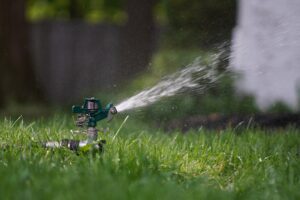
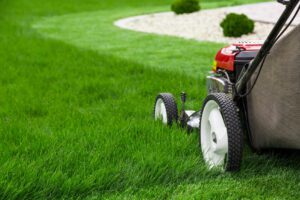 Adjust Your Mowing Routine
Adjust Your Mowing Routine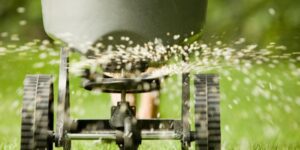 Fertilize Appropriately
Fertilize Appropriately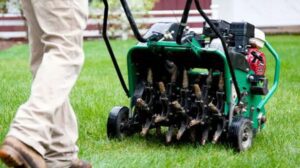 Aerate Your Lawn
Aerate Your Lawn Use Mulch to Retain Moisture In Your Planting Beds
Use Mulch to Retain Moisture In Your Planting Beds  Monitor for Pests and Diseases
Monitor for Pests and Diseases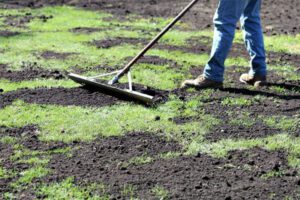 Consider Adding a Fresh Topcoat (Topdressing) to Your Lawn
Consider Adding a Fresh Topcoat (Topdressing) to Your Lawn 